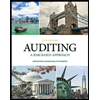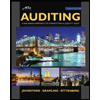
Concept explainers
a.
Introduction: Allowance for doubtful accounts is a contra asset account which is used to provide provision for losses which may result due to non-receipt of accounts receivables. The value of allowance is deducted from the figure of accounts receivables as presented in the
To describe: Basis for valuation of allowances for doubtful account, its comparison with account balances based on recorded transactions and precision requirement for balances containing estimates.
b.
Introduction: Uncollectible debt represent the debt which is not likely to be realized by the company, depending on the certainty of un-collectability, either an allowance (provision) can be made for the same or the debt can be written off by recognizing it as ‘
To describe:Information that the company may use to make the estimate of the allowance for uncollectible debt.
c.
Introduction: Audit Evidence refers to the evidence obtained by the auditor by performing
To describe: Evidence needed to be collected by auditor in order to determine the fairness of client’s estimate of the allowance for uncollectible accounts.
d.
Introduction: When the allowance is estimated based on past trends, as a percentage of sales, the same rate cannot be taken in the current period since the customer base has been altered and therefore, management would have to determine a new methodology for estimation.
To discuss:Effect of sale to low credit customers on estimate of allowance for doubtful debt.
e.
Introduction: Economic conditions are the prevalent market conditions within which the business operates, a business can only operate profitably when the economic environment within which it exits, allows the business sufficient opportunities.
To describe: Importance of change in economic conditions in estimation of allowance for doubtful accounts.
Want to see the full answer?
Check out a sample textbook solution
Chapter 6 Solutions
AUDITING-TEXT (LOOSELEAF)
- Expert need your helparrow_forwardI need assistance with this financial accounting question using appropriate principles.arrow_forwardHorngren's Financial & Managerial Accounting: The Managerial Chapters, 8th Edition. E-M:9-16 Using responsibility reports to evaluate cost, revenue, and profit centers The accountant for a subunit of Bellamy Sports Company went on vacation before completing the subunit’s monthly responsibility report. This is as far as she got: Subunit X Revenue by Product Actual Results Flexible Budget Variance F or U Flexible Budget Sales Volume Variance F or U Static Budget Downhill-RI $ 326,000 (a) (b) $ 19,000 F $ 301,000 Downhill-RII $ 154,000 (c) $ 164,000 (d) $ 148,000 Cross-EXI $ 280,000 $ 1,000 U $ 281,000 (e) $ 297,000 Cross-EXII $ 254,000 (f) $ 249,000 $ 16,500 U $ 265,500 Snow-LXI $ 424,000 $ 2,000 F (g) (h) $…arrow_forward
- Can you explain the process for solving this financial accounting problem using valid standards?arrow_forwardI need guidance with this general accounting problem using the right accounting principles.arrow_forwardI am trying to find the accurate solution to this general accounting problem with appropriate explanations.arrow_forward
 Auditing: A Risk Based-Approach (MindTap Course L...AccountingISBN:9781337619455Author:Karla M Johnstone, Audrey A. Gramling, Larry E. RittenbergPublisher:Cengage Learning
Auditing: A Risk Based-Approach (MindTap Course L...AccountingISBN:9781337619455Author:Karla M Johnstone, Audrey A. Gramling, Larry E. RittenbergPublisher:Cengage Learning Auditing: A Risk Based-Approach to Conducting a Q...AccountingISBN:9781305080577Author:Karla M Johnstone, Audrey A. Gramling, Larry E. RittenbergPublisher:South-Western College Pub
Auditing: A Risk Based-Approach to Conducting a Q...AccountingISBN:9781305080577Author:Karla M Johnstone, Audrey A. Gramling, Larry E. RittenbergPublisher:South-Western College Pub

